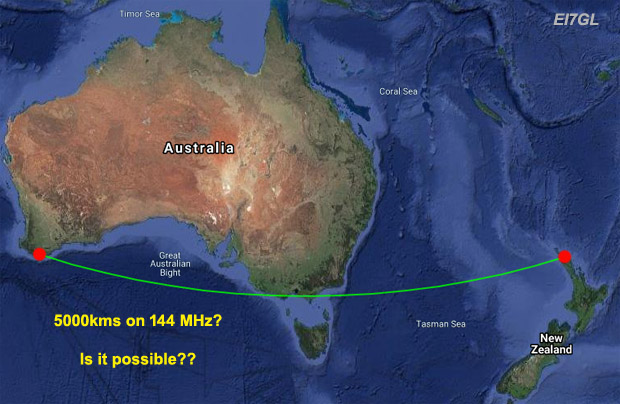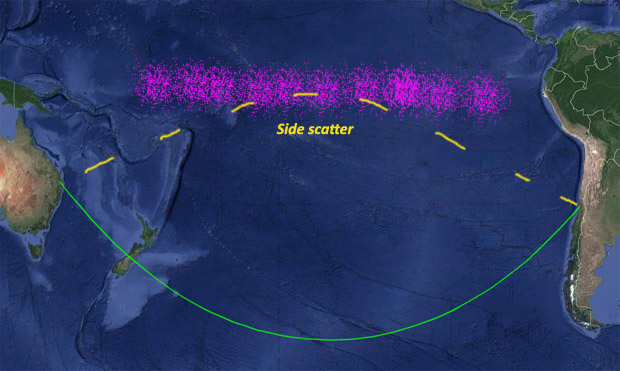VK3DXE in Australia recently posted this article on his Facebook page and it is republished here with his kind permission to reach a wider audience. In it, he outlines what attracted him to the VHF bands.
I've been a member of a number of VHF/UHF Ham pages for a while, and keep seeing a lot of misconceptions and myths being picked up and quoted over and over by newcomers, and sadly a lot of not-so-newcomers who’ve brought their HF Game with them to the higher bands.
I first became fascinated with VHF tropo propagation as a young kid living in the country, where we only had 2 TV channels, but occasionally we’d get the channels from the city suddenly appear when the conditions were right. You can imagine the excitement for a young kid way back then who's suddenly discovered some new TV channels! We had a neighbour up the hill who happened to be a Ham, and he explained to me how tropo worked. I was hooked, and from then on, whenever the weather forecast maps looked promising, and we got the right conditions, summer or winter, I’d start looking for the telltales that the city channels were going to pick up.
Fast forward 7 or 8 years, and I eventually got my Australian Novice license, quickly upgrading to the Advanced Call within a year when I was about 15 or 16. We were near the top of the sunspot cycle at the time, so I went nuts on HF for the next few years. But as the sunspots waned, I was drawn to the higher bands…..
As a youngster it was sometimes tough putting up a decent 2m yagi, but I always found a way of getting something in the air, and making the most of what I had available, even when living in rental housing. I just had to be creative, and sometimes a bit cheeky. The good thing about a 2m yagi though, was that even if anybody noticed it, they'd just figure it was a TV antenna.....
 |
| You can build a small yagi like this in an afternoon with some simple tools. |
I learned about aircraft enhancement in the days before we had all the funky tools we have today, before the widespread coming of the Internet. We managed to regularly make 2m SSB contacts of up to 700km (400+ miles) with smallish yagis and relatively low power - one path of 740km was quite good even with my portable station, with just a little 4 element yagi and Yaesu FT-290R II running only 2.5 watts!
Living in inner city urban areas, I really began to appreciate low noise antenna designs (DL6WU & K1FO were the early leaders) and radio frontends that didn't collapse in the presence of strong out of band signals. I learned about GaAsFET LNAs (Low Noise Amplifiers, or preamps) too, and the importance of what was in front of the radio on RX. You have to think of your station as a system.

In the early 1990’s the Bible of VHF+ was published. The VHF/UHF DX Book very quickly became the must-have tome in every serious VHFer’s library. Although some of the chapters are now a bit dated, especially those relating to equipment, I strongly suggest everybody with even a fleeting interest in the higher bands downloads a copy and reads it. Hopefully it’ll help to undo some of the myths about VHF+ that have persisted in the hobby for far too long, things like the belief that troppo is only a summertime thing, and that troppo is the only worthwhile propagation mode on VHF+. Download it here: http://www.trpub.net/assets/applets/VHF-UHF_DX_Book.pdf
As the Internet came along and people developed all sorts of new tools, and we learnt about Forums, email reflectors, and then FaceBook pages, the opportunities to learn and collaborate grew amazingly.
Then the WSJT suite of software changed things overnight. All of a sudden, the little guys running just 100w to a 10 element yagi could successfully work stations on the other side of the world on 2m and above via EME, or Earth-Moon-Earth. I worked a dozen countries with just a single yagi and less than 200w at the antenna.
Just last weekend, I was listening to HB9Q in Switzerland on 23cm for hours here in my /P shack while we're living in temporary accommodation, with a beautiful steady signal, often quite audible in the speaker, all on a tiny 60cm x 90cm gridpack antenna.
Eventually, once I get my 2.4m dish in the air and find a suitable amplifier, I hope to be able to work him on 23cm SSB at home.... JT65 and Q65 will be an absolute walk in the park.
 |
| Lots of signals on 23cm with the gridpack. |
In Australia, where we don’t have the population of Europe or North America, the Ham fraternity have embraced WSPR on 2m, and have demonstrated VHF paths of sometimes thousands of kilometres that no amount of listening to white noise for beacons or a coincidentally-timed CQ would find with the naked ear. Those paths are now being exploited regularly on digital modes, with people moving to SSB when conditions become strong enough. I've been around the hobby for a long time, but so too have the "old farts", some of whom vociferously decry the use of digital modes, but our experience here in Australia has really demonstrated how digital modes can be exploited to help get those SSB contacts that very probably would never have taken place otherwise. WSPR has been so successful that there are now WSPR beacons on Hawaii (often heard on West Coast USA), and in New Zealand, with a fantastic signal into East Coast Australia during the summer tropo season.
 |
| A little 4 element Cushcraft yagi. Even this is enough to decode some of the Big Guns off the Moon. I had many WSPR 2-ways with this one, out to 700km with Aircraft Enhancement |
Next time you're asked by anybody (PARTICULARLY CHILDREN AND YOUNG PEOPLE) about the hobby, instead of trying to excite them with boring stories of talking on HF or FM repeaters, which they tend to equate with the equivalent of dialing random numbers on their cellphone to talk to old farts with bad combover hairstyles about their hemorrhoids, try telling them about stuff like all the space comms stuff we have access to, and can actively participate in, like using the repeater on the ISS, and all the other satellites we have access to. Tell them about Moonbounce, and how you can actually demonstrate the speed of light in action - you know exactly when the station on the other end has stopped transmitting, but can still see and hear his signal coming back at you for those additional 2 or 3 seconds it takes to travel all the way to the Moon and back. THAT gets young people more excited than listening to old farts! Try talking to them about meteor scatter, and how the military has used it for communication systems to counter the effects of comms satellites being wiped out in a conflict, or a dirty big EMP bomb wiping out HF. Tell them about aircraft enhancement, which is really bistatic radar, and how some clever dude worked out a way of using it to detect stealth aircraft by using commercial broadcasters behind enemy lines to illuminate the target. Tell them about all the really funky atmospheric and weather science they can learn just by playing with weak signals on VHF+. Tell them about the funky networking knowledge they can gain from modes like D-Star, IRLP, Echolink, etc.
 |
| The /P shack while I'm away from home |
Anyways, I've written this piece in response to a recent influx of newcomers and not-so-newcomers to the higher bands, possibly on the back of purchasing themselves a brand new IC-9700. I fully appreciate that everybody starts their learning journey from different places and has different interests, but some of the myths and misunderstandings I see are staggering. Unfortunately, so much of the Ham narrative has become very HF-centric, and that mindset often pervades discussions, and the marketing of the hobby, so this is just my little bit to try to counter some of that. Remember to download the VHF/UHF DX Book from the link above, and jump onto some of the more technical pages and start learning.
I'll be doing a bit of a write up soon on the importance of frequency accuracy and STABILITY on VHF+. Watch this space.
Enjoy!
de VK3DXE








































